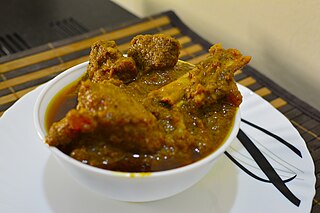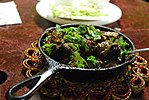
Kebab, kabob, or kebap or kabab is roasted meat that originates from the Middle East and has been popularised by Iranian cuisine and Turkish cuisine. Many variants of the category are popular around the world, including the skewered shish kebab and the doner kebab with bread.

Pakistani cuisine can be characterized as a blend of regional cooking styles and flavours from across South, Central and Western Asia. Pakistani cuisine is influenced by Persian and Arab cuisine. The cuisine of Pakistan also maintains certain Mughal influences within its recipes and cooking techniques. The country's various cuisines vary across the country. Pakistan's ethnic and cultural diversity, diverse climates, geographical environments, and availability of different produce options reason for the uniqueness of pakistani cuisine.

Bengali cuisine is the culinary style of Bengal, that comprises Bangladesh and the Indian states of West Bengal and Tripura. The cuisine has been shaped by the region's diverse history and climate. It is known for its varied use of flavours including mustard oil, as well as the spread of its confectioneries and desserts. There is a strong emphasis on rice as a staple, with fish traditionally the most common protein. Freshwater fish are preferred to seafish, although barramundi, known as bhetki, is also common. Meat is also a common protein among Bengalis with beef and goat meat being the most popular. In more recent times, lentils have begun to form a significant part of the diet. Many Bengali food traditions draw from social activities, such as adda, Eid feast or the Mezban.

Pilaf or pilau is a rice dish, or in some regions, a wheat dish, whose recipe usually involves cooking in stock or broth, adding spices, and other ingredients such as vegetables or meat, and employing some technique for achieving cooked grains that do not adhere to each other.

Iranian cuisine is the culinary traditions of Iran. Due to the historically common usage of the term "Persia" to refer to Iran in the Western world, it is alternatively known as Persian cuisine, despite Persians being only one of a multitude of Iranian ethnic groups who have contributed to Iran's culinary traditions.

South Asian cuisine, includes the traditional cuisines from the modern-day South Asian republics of Bangladesh, India, Maldives, Nepal, Pakistan and Sri Lanka, also sometimes including the kingdom of Bhutan and the emirate of Afghanistan. Also sometimes known as Desi cuisine, it has been influenced by and also has influenced other Asian cuisines beyond the Indian subcontinent.

Kabab koobideh or Kobide is an Iranian type of kofta kabab made from ground lamb or beef, often mixed with ground pepper and chopped onions.
Bhojpuri cuisine is a style of food preparation common among the Bhojpuri people of Bihar and eastern Uttar Pradesh in India, and also the Terai region of Nepal. Bhojpuri foods are mostly mild and tend to be less hot in terms of spices used. The cuisine consists of both vegetable and meat dishes.

Afghan cuisine is influenced to a certain extent by Persian, Central Asian and Indian cuisines due to Afghanistan's close proximity and cultural ties. The cuisine is halal and mainly based on mutton, beef, poultry and fish with rice and Afghan bread. Accompanying these are common vegetables and dairy products, such as milk, yogurt, whey, etc., and fresh and dried fruits such as apples, apricots, grapes, bananas, oranges, plums, pomegranates, sweet melons, raisins, etc. The diet of most Afghans revolves around rice-based dishes, while various forms of naan is consumed with most meals. Tea is generally consumed daily in large quantities, and is a major part of hospitality. The culinary specialties reflect the nation's ethnic and geographic diversity. The national dish of Afghanistan is Qabili Palau, a rice dish cooked with raisins, carrots, nuts, and lamb or beef.

Hyderabadi cuisine, also known as Deccani cuisine, is the native cooking style developed in the kitchens of the Muslim aristocrats of the erstwhile Hyderabad State, India. The haute cuisine of Hyderabad began to develop after the foundation of the Bahmani Sultanate, and the Qutb Shahi dynasty centered in the city of Hyderabad promoted the native cuisine along with their own. Hyderabadi cuisine had become a princely legacy of the Nizams of Hyderabad as it began to further develop under their patronage.
Cuisine of Uttar Pradesh is from the state of Uttar Pradesh (UP) located in Northern India. The cuisine of UP has a large variety of dishes. The cuisine consists of both vegetarian and non-vegetarian dishes of different varieties. Being a large state, the cuisine of UP share lot of dishes and recipes with the neighboring states of Delhi, Uttarakhand, Bihar, Jharkhand and Haryana. Apart from native cuisine, Mughlai, Awadhi and Bhojpuri are famous subtypes of cuisine of the state.
Awadhi cuisine is a cuisine native to the Awadh region in Northern India. The cooking patterns of Lucknow are similar to those of Central Asia, the Middle East, and Northern India and western India with the cuisine comprising both vegetarian and non-vegetarian dishes. The Awadh region has been influenced by Mughal cooking techniques, and the cuisine of Lucknow bears similarities to those of Central Asia, Kashmir, Punjab and Hyderabad. The city is also known for its Nawabi foods.
Bihari cuisine is eaten mainly in the eastern Indian state of Bihar, as well as in the places where people originating from the state of Bihar have settled: Jharkhand, Eastern Uttar Pradesh, Bangladesh, Nepal, Mauritius, South Africa, Fiji, some cities of Pakistan, Guyana, Trinidad and Tobago, Suriname, Jamaica, and the Caribbean. Bihari cuisine includes Bhojpuri cuisine, Maithil cuisine and Magahi cuisine.

Lahori cuisine refers to the food and cuisine of the city of Lahore in Punjab, Pakistan. It is a part of regional Punjabi cuisine. Lahore is a city with an extremely rich food culture. People from Lahore are famous all over the country for their love for food. The city offers a vast variety of options when it comes to gastronomy. In recent times, the style of food has achieved popularity in a number of different countries, because of its palatable and milder taste, mainly through the Pakistani diaspora.

Chapli Kebab or Chapli Kabab is a Pashtun-style minced kebab, usually made from ground beef, mutton or chicken with various spices in the shape of a patty. The Chapli Kabab originates from Peshawar in Pakistan. The Peshawari Chapli Kabab is made with beef and is a popular street food throughout South Asia, including Pakistan, India, Afghanistan and Bangladesh.

Karachi cuisine refers to the cuisine found mainly in the city of Karachi, Sindh, Pakistan. It is a multicultural cuisine as a result of the city consisting of various ethnic groups from different parts of Pakistan. Karachi is considered the melting pot of Pakistan.

Muhajir cuisine refers to the food and culinary style of the Muhajir people in Pakistan, the descendants of Muslim migrants from India who migrated to Pakistan following the partition of India. Most Muhajirs have traditionally been based in Karachi, hence the city being known for Muhajir tastes in its cuisine. This cuisine has a rich tradition of many distinct and local ways of cooking. Muhajirs clung to their old established habits and tastes, including a numberless variety of dishes and beverages.

Mutton curry is a dish that is prepared from goat meat and vegetables. The dish is found in different variations across all states, countries and regions of the Indian subcontinent and the Caribbean.

Mughlai paratha is a popular Bengali street food consisting of a flatbread (paratha) wrapped around or stuffed with keema and or egg. It is believed to have originated in Bengal Subah during the time of the Mughal Empire as a derivative of the Turkish Gözleme. The dish is believed to be prepared for the royal court of Mughal Emperor Jahangir.
Indian cookbooks are cookbooks written in India, or about Indian cooking. Some of the oldest cookbooks were written in India Indian cooking varies regionally and has evolved over the centuries due to various influences. Vegetarianism has made a significant impact on Indian cooking. Spices play a major role in Indian cooking.












